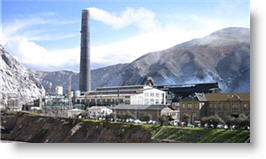 Creditors of Doe Run Peru, the metals producer that has operated the La Oroya metallurgical complex since 1997, turned down the company’s restructuring plan and opted instead for “liquidation in process,” the government said.
Creditors of Doe Run Peru, the metals producer that has operated the La Oroya metallurgical complex since 1997, turned down the company’s restructuring plan and opted instead for “liquidation in process,” the government said.
The creditors met Thursday to vote on the restructuring plan. Rosario Patiño, the legal representative of the Mines and Energy Ministry, which is the biggest creditor, said the restructuring plan presented by Doe Run Peru on Thursday was “unfeasible,” which led the board of creditors to support liquidation.
“The first thing that was voted on was the restructuring plan, but it had many conditions that were impossible for the state,” daily El Comercio reported Patiño as saying.
Patiño said the conditions that Doe Run Peru wanted included an extension to its environmental cleanup program. The plan also called for the government to take responsibility for lawsuits that have been filed against the Renco Group, which owns Doe Run Peru, in the United States. The lawsuits were filed by a group of La Oroya residents over environmental pollution caused by the company’s smelter.
“This made the plan unfeasible,” said Patiño.
Patiño said the liquidation process does not necessarily mean that the La Oroya plant will be liquidated or that the some 3,500 workers in La Oroya will lose their jobs.
Luis Castillo, the head of Peru’s national mining federation, said that workers will evaluate the plan and did not rule out that they could hold protests over concerns that they will lose their jobs.
The smelter, built and operated by the Cerro de Pasco Corporation since 1922 and nationalized in 1971 by Peru’s military government led by General Juan Velasco, has always been a serious polluter.
Doe Run acquired the operation in a privatization program during the Fujimori administration when the winning bidders, Industrias Peñoles of Mexico, backed out.
At the time, the government recognized the complicated aspects of the privatization due to environmental and social concerns – the environmental damage in La Oroya was so severe that Rio Tinto, a large British mining company, decided it was not worth buying. The privatization package required that the new owners would have to invest at least $132 million over the first five years and up to $330 million over ten years to bring the refinery complex up to environmental standards required by law.
As part of the purchase agreement signed in 1997, Doe Run —which acquired the complex for $247.9mn— agreed to comply with a 10-year environmental cleanup and management plan, or PAMA. That plan was extended a number of times, more than doubling the investment required for the cleanup.
Doe Run completed eight of its nine environmental projects, including all water sources and the areas for slag heaps, and has considerably reduced emissions of arsenic and lead.
Yet despite these considerable improvements made by Doe Run after taking the complex over from the state mining company Centromin, the Blacksmith Institute ranks La Oroya as one of the world’s top ten polluters. Scientists at St. Louis University’s School of Public Health found that 97% of children in La Oroya suffer from mental and physical defficiencies due to high lead content in their blood.
The complex has been shut down since 2009, when Doe Run was unable to secure financing to complete the ninth environmental project. Doe Run’s debt is more than US$442 million, 36% of which is owed to the Peruvian government.






Pingback: Pay the polluter $800 million! Trade deal injustice for the children of La Oroya. - Friends of the Earth